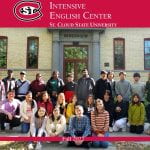10 Things I’ve Learned as an ESL Teacher
By: Molly Sand, ESL Teacher
Albert Einstein once said, “It is the supreme art of the teacher to awaken joy in creative expression and knowledge.” I chose this quote because it represents some of the qualities of good teaching. Since a young age, I always enjoyed going to school, learning new things, and helping others learn. When someone achieves in school, it brings me a lot of joy.
I realized I wanted to become a teacher of English as a Second Language after my high school English teacher inspired me to research the subject. She knew I planned to major in English and witnessed me teach a variety of children as a swim instructor. This teacher helped me believe in my abilities and apply them to my future. By doing so, I was able to follow my dream of becoming a teacher by studying at St. Cloud State University (SCSU).
At SCSU, I dedicated a lot of time to my students through multiple field experiences provided by the Linguistics and TESL programs. Those experiences allowed me to work with various ages and ability groups learning English. When I was not in the classroom as a student or a teacher, I was working in the Intensive English Center (IEC). As an IEC student worker, I had many opportunities to interact with international students, aide them throughout the application process, and provide guidance for our campus. Now, I am a licensed ESL teacher and have finished my first year. I have learned many things. Here are 10 things I would like to share with other aspiring teachers:
- Professional development trainings provide plenty of literature on teaching. They also provide resources such as technology training, lesson development, and cultural awareness and sensitivity training. Take advantage of any professional development offered to you.
- Teachers Pay Teachers is a fantastic resource. You can find countless activities and lesson materials, free or low cost. As teachers, it is easy for us to become consumed with lesson planning. Avoid teacher “burnout” by taking inspiration from outside sources. Of course, you will create activities and lesson plans from scratch, but don’t feel obligated to do this every time. https://www.teacherspayteachers.com/
- Mentors are invaluable! Look to your colleagues and experienced teachers for help and advice. They have so much knowledge and a willingness to share it with new teachers. Observe your mentor or other colleagues. You can benefit from studying their various teaching styles and classroom atmospheres. There is always room for growth in a classroom.
- Co-teaching provides students with two well trained educators from different fields. For example: a co-taught math class can consist of a math teacher and an ESL teacher. They share the stage and work together using their expertise to educate a blended classroom. Co-teaching can be a challenge, but there are many ways to structure the teaching relationship. It is extremely important to show respect, clearly define roles and responsibilities, be flexible, and plan together.
- Asking for help is not a sign of a poor teacher. It is a sign of a teacher who is willing to work with others and grow in the profession.
- Over–planning for a unit is better than under-planning. Students have different degrees of abilities and planning extra practice/activities will benefit more students. There are students who will complete tasks quickly and will need more work to keep them on task. Extra practice and explanation will only help your students achieve more.
- Movement is essential for students. You should create activities that allow students to get out of their seats and converse with their peers. An activity I have used is called Notice and Wonder. Each student must find a partner and remain standing while sharing their knowledge, questions, or comments about a displayed image. Each student then shares their comments with the entire class. ELL students are able to talk about the lesson and practice using the language of the subject (i.e. language of math, using math terminology, etc.). It also encourages students to work together.
- Encourage conversations during work time and free time. ELL and mainstream students benefit from socializing. ELL students are able to practice their English skills with native English speakers. When creating a seating chart provide opportunities for students to interact with students they don’t normally interact with.
- Get to know your students. Where are they from? What are they interested in? They are all individuals and you could be the teacher who helps them express their story.
- Try, try again. Sometimes, if a lesson doesn’t go well, chalk it up to experience and try again another day. Not every lesson may go as planned during the first few years of teaching. It takes time to develop classroom management strategies and lessons that work for you and your students.
I hope you found this list helpful. My most important point is to use your resources. In any situation, there are people and teaching materials to help you along the way. Whether they be colleagues, trainings, or technology, use them! There is no harm in using them—they will provide a better learning environment for your students. Students and classrooms are constantly evolving. Make sure you are able to adapt with them to provide an engaging and inspirational learning environment.
















